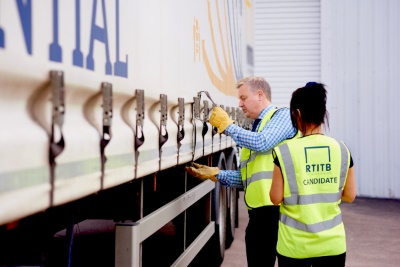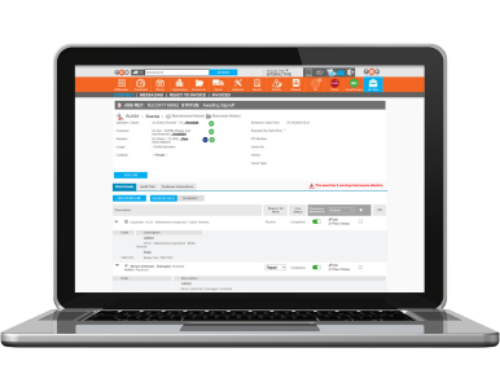Keeping loads secure with eLearning
 Laura Nelson, managing director at RTITB, offers advice on load security and explains how online compliance training can help
Laura Nelson, managing director at RTITB, offers advice on load security and explains how online compliance training can help
According to the Health and Safety Executive, falling objects in road freight cause injuries, and even death. It is clear why load security is a focus for DVSA, and an area that DVSA enforcement officers will inspect.
LGV/HGV drivers are ultimately responsible for the placement, condition and security of loads. That means it’s important they are aware of the pallets aboard and the load they are carrying, as well as how it should be loaded correctly.
So, to reduce the risk of incidents and improve compliance, it’s essential that logistics, haulage, and transport companies keep driver knowledge on safely securing loads on vehicles is up to date.
RTITB makes this simple, with a bitesize Driver Compliance eLearning module focused on load security for palletised loads. This microlearning topic can be completed online in less than 10 minutes.
You could also remind drivers of four key points today to help keep palletised loads safe and secure.
1. Check pallet condition and stability
Before attempting to apply restraints to the load, check the condition and stability of the pallets. Are they stable and freestanding?
Do not accept pallets that you think are not strong enough to bear the load, and ensure the load cannot slide on the pallet. The load must not be ‘loose’ to move around on the pallet. Consider the possibility of the load toppling/collapsing during transit or unloading. Shrink wrap and banding, for instance, restricts movement, but it will not prevent movement. Always check that wrapping and banding is intact to minimise the possibility of goods falling from pallets in transit or during unloading.
2. Stacking palletised loads
 Sometimes, it may be necessary to stack one palletised load on top of another. If this is the case, the cargo on the lower pallet needs enough structural strength to support the upper pallet. It must also be attached firmly to the lower pallet.
Sometimes, it may be necessary to stack one palletised load on top of another. If this is the case, the cargo on the lower pallet needs enough structural strength to support the upper pallet. It must also be attached firmly to the lower pallet.
The cargo must be strong enough to hold the weight of everything stacked on top of it without being damaged, crushed or warped. As with any other load, drivers must keep checking the condition of any pallets.
3. Planning the load
Palletised loads can be very varied. Irregular sizes, differing pallet types, and a variety of goods can all make positive fit a challenge. Think carefully about how best to use space.
Dunnage and packaging can be used to fill gaps, but it is better still if the gap is not there. Two palletised loads (one on top of the other) provide better stability and trailer fill than a single high-loaded pallet, for example. Always lash over the top and secure to the vehicle chassis or ‘rave-to-rave’.
Remember to consider the dimensions of the pallets and trailer. It might be possible to make better use of space loading pallets one way rather than another.
Know the weights of the pallets. Distribute weight evenly and ensure the axle weights are not exceeded Put heavy loads against bulkheads where possible to prevent them moving and building momentum.
Finally, treat loads of empty pallets like a standard timber load. You need to use an appropriate method to secure the load, such as lashings. Do not rely on the curtains of a standard curtainsider!
4. Securing the load
Frictional lashing is one of the most commonly used methods of securing palletised loads. The lashings create downward pressure which increases the effects of friction between the load and load bed. It’s the increased friction which helps stop the load moving. The straps should be at a steep angle to ensure good downward force. If a steep angle cannot be achieved, then lightweight but durable packing can be placed on top of the pallet to increase the angle.
But too much slack and the load can leave the load bed or shift during acceleration, braking, or cornering. An airborne load experiences zero friction. Nothing is stopping it. Maintain the tension and maintain the friction.
Load security also depends on the lashings themselves. For example, straps are rated for particular load weights. However, the rating should not be taken for granted on straps that are several years old. Wear and tear and exposure to the elements can lead to weakening. Straps should be stored in a weatherproof compartment when not in use, so they don’t degrade. Check your straps regularly to ensure they are fit for purpose.
Also, remember Nylon based straps weaken and stretch when they get wet. They should not be used on exposed loads. And you should never use a knot in any part of a ratchet strap.
Other load securing options may also be a good fit for certain load types, such as shrink wrap, for pallets stacked with items that have similar dimensions, webbing nets that can help prevent loads falling if they have shifted in transit, corner protectors which can protect the items on the pallet by spreading force and providing support. Finally, anti-slip mats can provide greater friction between the load and load bed.
 Finally, if the vehicle carries manual handling equipment (MHE) for loading/unloading, that, too, is part of the load. Secure MHE appropriately, using securing points if present.
Finally, if the vehicle carries manual handling equipment (MHE) for loading/unloading, that, too, is part of the load. Secure MHE appropriately, using securing points if present.
Reduce load security risks now
A comprehensive approach to palletised load security emphasises the importance of careful planning, regular inspections, and proper use of load securing equipment. Implementing these practices and Driver Compliance eLearning in your operations can help improve safety and prevent issues.












